Overview & Trends: IT Outsourcing in 2025


| up to 60% |
“Master your strengths, outsource your weaknesses.”
According to the grand view research, the global IT outsourcing market size was estimated at USD 245.91 billion in 2021 and is expected to reach USD 261.9 billion in 2022. An outsourcing strategy gained recognition among businesses of all types and from multiple industries. Tech giants like Google, Facebook, and IBM as well as manufacturers like Nike and Coca-Cola outsource part of their business operations connected with IT to dedicated offshore teams.
This phenomenon has a lot of issues for discussion that we are happy to cover in this article. It contains everything you wanted to know about IT outsourcing and a little more. The full list of covered issues placed in alphabetical order is here:
- Benefits the companies get when they outsource some functions
- Budgets that companies spend on IT department
- COVID impact
- Forms of outsourcing
- Functions that company prefer to outsource
- Models of outsourcing
- Rate range per region
- Reasons why companies outsource
- Regions overview
- Risks you should be aware of
- Specialists market overview
- Trends that drive outsourcing market in 2022
1. What Is Outsourcing?
Today it has become a very common practice to work with external vendors to process various business activities, starting with operational things like payroll, inventory management, content development, or hiring through an employment agency to business processes management.
It is a practice that is becoming more and more widespread that allows companies of all sizes to do their business and grow without major risk or investment when it’s done correctly.
- The outsourcing industry’s total value is estimated to hit $405.6 billion by 2027.
- Outsourcing helps companies reduce costs by about 15% on average but up to 60% .
- 30% of the US-based companies outsource at least one function, and this IT outsourcing trend is not declining.
- 57% of companies outsource their work to increase productivity.
- 24% of SMBs that outsource do so to increase efficiency.
- 64% of outsourced services are related to software application development.
2. What Is IT Outsourcing?
IT outsourcing is the practice of working with external vendors to handle some information technology functions.
2.1. Top 10 Outsourced IT Functions
| Application development | a service provider is responsible for developing new or enhancing existing applications (web, mobile, etc) |
| Application maintenance & support | a service provider takes over ongoing maintenance of existing applications |
| Datacenter operations | a service provider helps to operate the data center (alone or with the help of an inhouse team) |
| Database administration | a service provider monitors and tunes databases (can be done at the physical or logical levels) |
| Desktop support | a service provider is responsible for the installation, maintenance, or support of PCs |
| Disaster recovery | a service provider is responsible for off-site data storage, recovery data centers, or redundant systems or networks used in the event of a disaster |
| Help desk outsourcing | a service provider deals with any type of phone or electronic response to end-user incidents |
| IT security | a service provider performs security-related functions (security assessments, penetration testing, managed security services, etc) |
| Network operations | a service provider is responsible for data network operations and monitoring |
| Web hosting and operations | a service provider hosts operates, or maintains a corporate website/application/ ecommerce platform |
3. Why Companies Outsource
The opposite of outsourcing development is an in-house development.
A company may outsource part of its activities like HR activities, software development, etc. Let’s find out why.
The Delloite did a great job and wrote two studies regarding the state of the outsourcing market. The studies date 2016 and 2020. We are waiting for new research to appear in 2025. Following the research made by Deloitte in 2016, there are a few reasons why companies outsource.
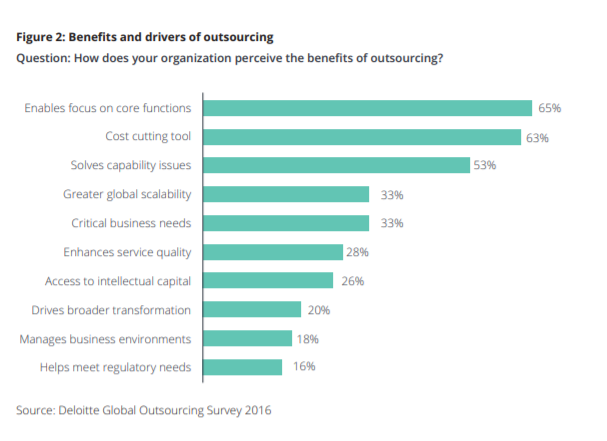
- 63% of companies outsource to reduce or control costs.
- 65% do it to focus on business objectives.
- 53% to solve capacity issues.
- 28% to improve service quality
- 26% to take help from talented professionals
- 18% to manage their business environment
81% of outsourcing buyers and vendors surveyed previously affirm the importance of technology as a means to achieve improved cost and quality benefits.
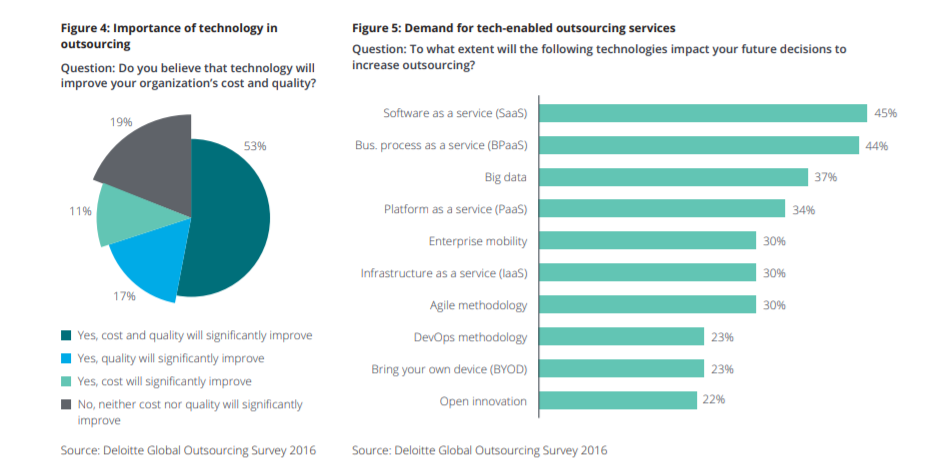
The general picture changed in 2020. According to the Deloitte research in 2020, cost reduction became a primary objective for 70% of companies.
Other objectives are:
- 40% of companies outsource to gain greater flexibility.
- 20% do it to speed to market.
- 14% to access tools and processes.
- 14% to get greater agility.
We see that cost reduction became increasingly critical again with over half of interviewees indicating that cost reduction is a primary reason for outsourcing.
3.1. IT Specialists Market Overview
One of the reasons why companies outsource their IT tasks is to get access to additional IT specialists with the experience and expertise needed. Finding them can be a challenging task for most businesses. To give a clear picture of why this point is becoming one of the drivers for IT outsourcing growth, we would like to make a short overview of the current IT jobs market overview.
The demand for new specialists experienced in complicated technology is considerably increased in the USA, Canada, and Western Europe. The developers in Eastern Europe are especially in demand.
The US Bureau of Labor Statistics data shows: that software development is among the most demanded professions and is on the top of the median earnings. These regions are facing the most prominent a lack of workforce. As the demand is higher than the supply, the available specialists increased their service prices significantly.
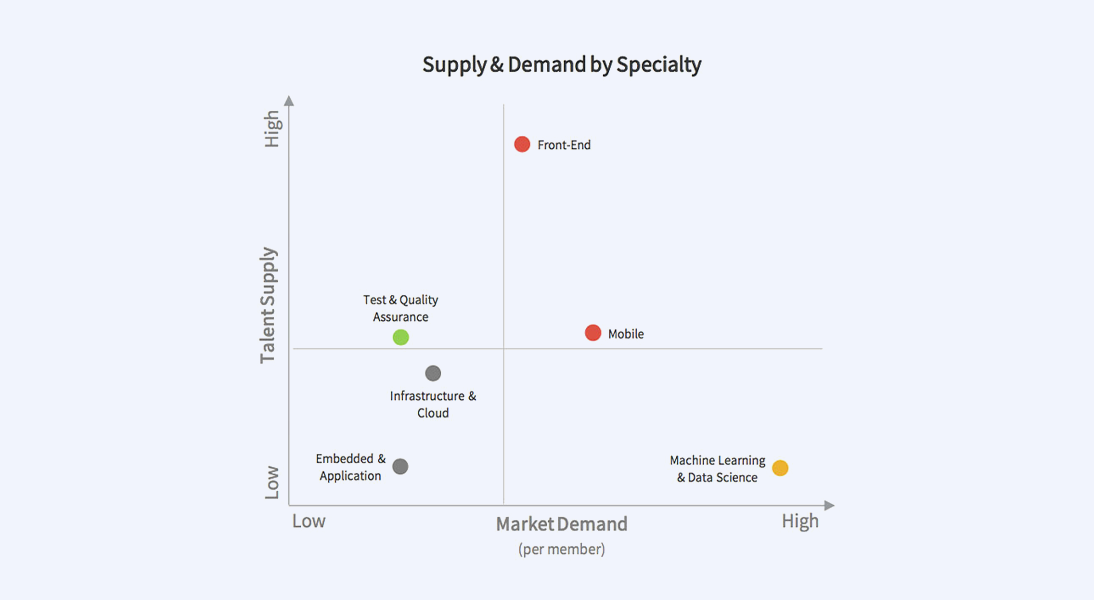
The Bureau of Labor Statistics predicts employment growth of 31% by 2026 in the USA. About 255,400 IT jobs are expected to be opened up within this period. Besides, we see an increase in wages in the IT sphere.
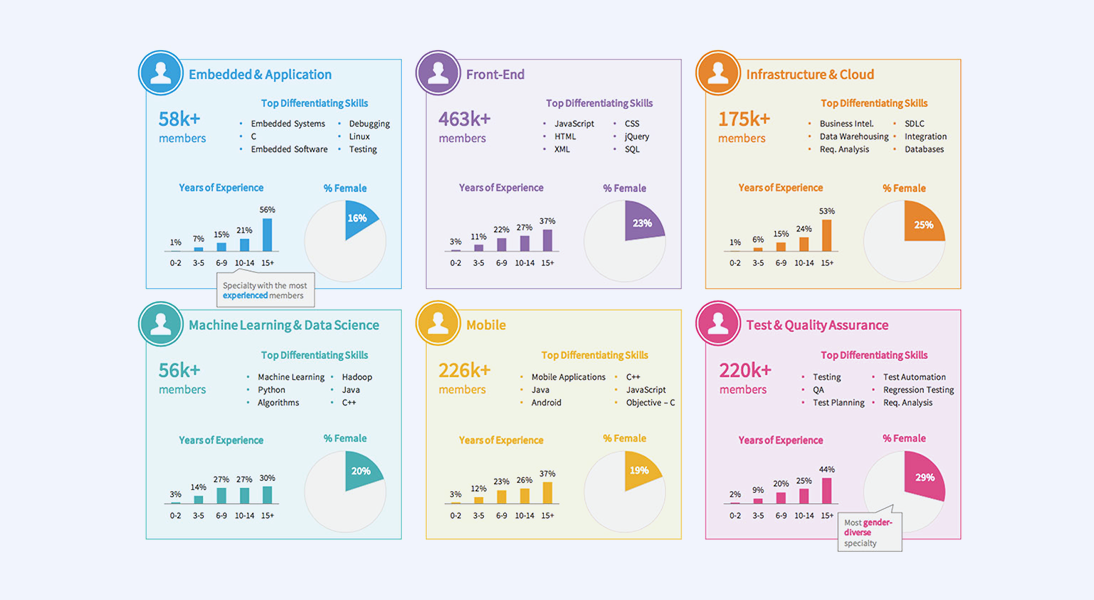
Increase in wages in the IT sphere.
This is the growth of approximately 3% while the general U.S. wage growth is 1,8%.
Such factors as specialty, education, employers, and regions should also be considered. Metropolitan cities are definitely the best-paid regions. Cities like San Francisco, NYC, Seattle, San Jose, California are among the most expensive places to hire a software developer in an entire world.
Covid-19 Impact
Covid-19 is an event that changes a lot of lives and businesses. It has influenced the outsourcing sphere and brought new IT outsourcing trends. Due to Covid-19 in 2020 many businesses started to use remote work and move their offices from Silicon Valley to less expensive regions, like Texas.
3.2. IT budgets
Before Covid-19 we also observed constant IT spending growth. It takes into account all expenses on technologies upgrade, better customer experiences, security, and business management.
Since the spending grow by 2-3% every year, the market requires thousands of new skilled developers of various technologies, old and new ones.
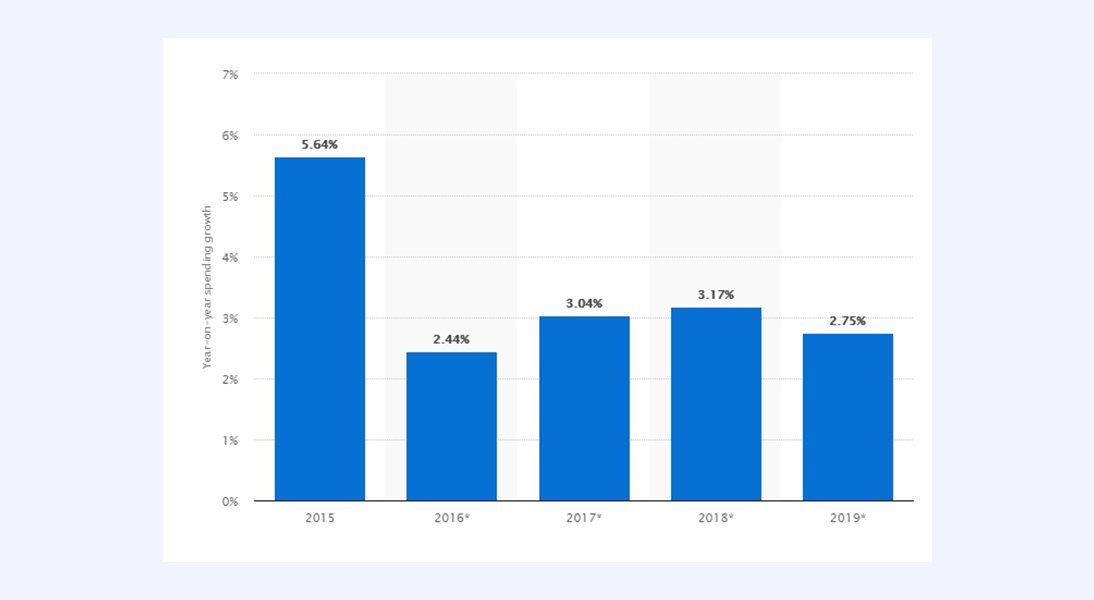
Covid-19 Impact
As business income stagnates, we may expect IT spending to decrease. Although the year-on-year growth has slowed slightly, it is expected that the growth of the IT budget in 2022 will exceed the contract.
In fact, 80% of companies in North America and Europe expect year-on-year technology spending to remain the same or increase (up 33.3% compared to 46.3%). At the same time, 17% of organizations expect IT budgets to fall in 2022, which greatly exceeds the expected 8% reduction in organizational budgets in 2020.
80% of companies surveyed expect IT budgets to grow or remain stable in the next 12 months.
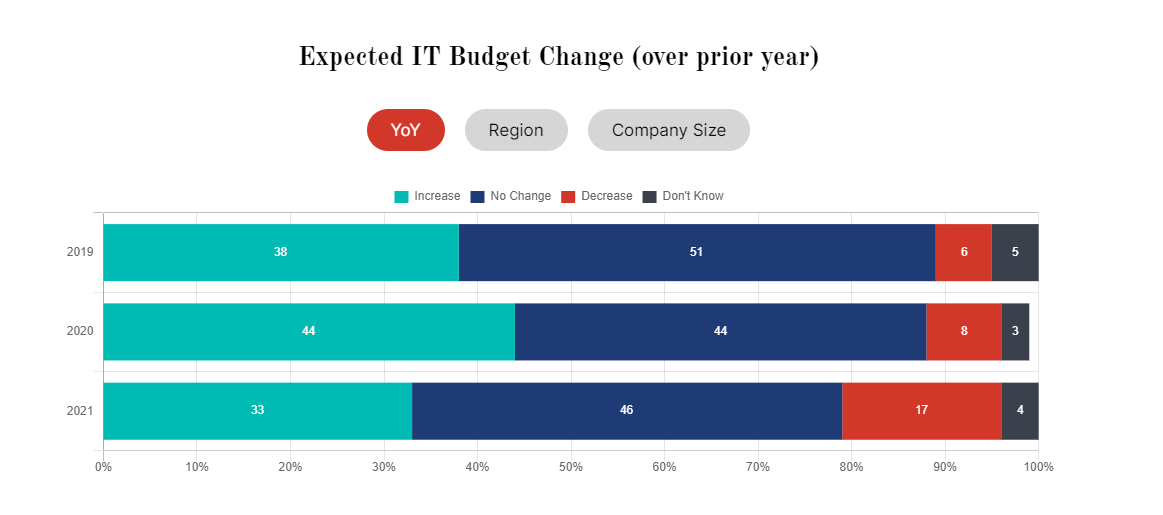
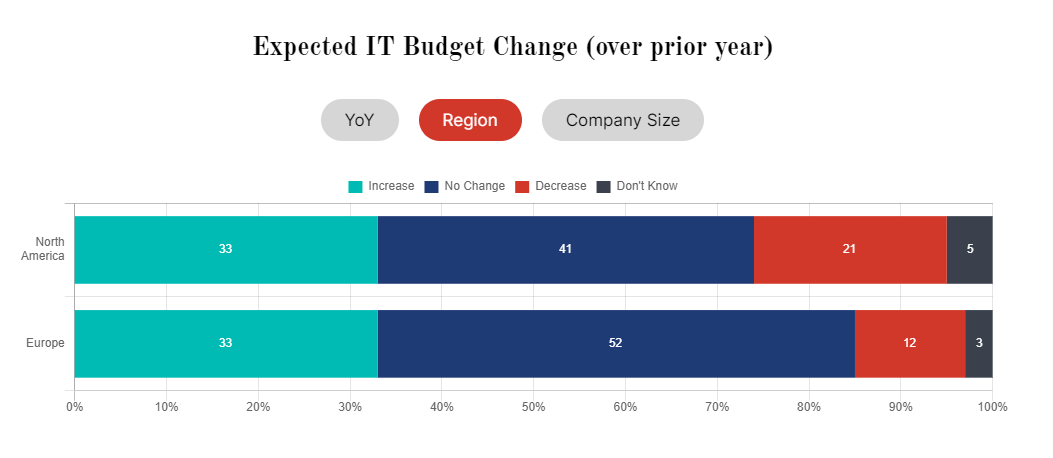
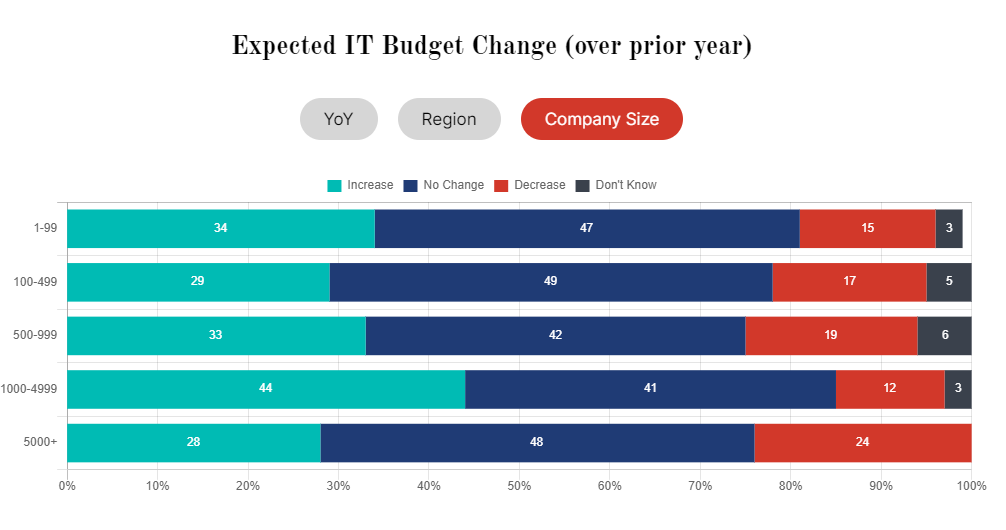
4. Forms of Outsourcing
Outsourcing is an umbrella term and it has a few types depending on the location of the 3rd party service provider chosen to work with. There are a lot of guides on how to choose a reliable Outsourcing service provider or how to outsource the development of various apps like a mobile application.
| Term | Definition | Sample |
|---|---|---|
Offshore outsourcing |
It is outsourcing of services to some company or individual located at a distance. Usually, the offshore outsourcing results it lower labor costs, better economic conditions, time zones, or a larger talent pool. Time difference with the service provider is at least 5-6 hours. |
A US business outsources app development to a software development company. |
Nearshore outsourcing |
It is outsourcing of services to some company or individual located not far from the location of the business. Nearshoring may result in smoother communication compared to offshoring thanks to the less time difference and cultural crossover. Time difference with the service provider is about 2-3 hours. |
A company based in Germany hires an iOS developer from Poland. |
Onshoring (homeshoring) |
It is about hiring a service provider within national borders. Usually the chosen location has lower operational and labor costs. |
A US company hired an accounting company within the state. |
Multisourcing |
It is outsourcing business processes to multiple vendors in order to diversify the risk in vendor operations. |
A UK-based company has several internal IT projects and works with various IT companies on them. |
4.1. Main Regions for IT Outsourcing
Outsourcing destinations are usually grouped by the location of the companies. However, they are also characterized by other criteria like:
- qualification
- language requirements
- cultural similarity
- time difference
- service costs
Regions overview
| Region | Qualification | Language | Cultural Similarity |
|---|---|---|---|
| Eastern Europe | High-quality education and expertise | Good English | Closely matched to the Western one |
| Asia and the Middle East | The high amount of developers, however, the qualification may differ greatly | Still-improving | The Eastern mindset is totally different from the European one. |
| Latin America | Sometimes immature business processes and a lack of technical skills | Relatively low English level | There are cultural differences that should be taken into consideration |
Overlapping working hours
| Region | Eastern Standard Time (EST) | Central European Time (CET) |
|---|---|---|
| Eastern Europe (Eastern European Time, EET) | 4 hours | 9 hours |
| Asia (India Standard Time IST) | 2 hours | 3 hours |
| Latin America (Mexico, CST) | 8 hours | 3 hours |
Global Software Outsourcing Rates
Software outsourcing rates vary depending on a lot of factors. One of the key factors is the location.
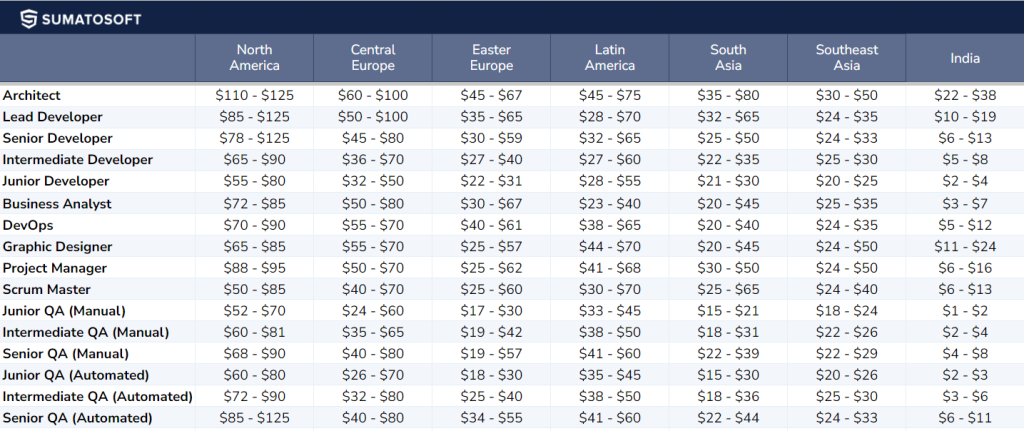
5. IT Outsourcing Models
Besides outsourcing types based on the location, there are also 3 main outsourcing models that describe the relationships between the business and the IT service vendor.
| Model | Description | Sample |
|---|---|---|
| Workforce augmentation (staff augmentation) | It is a strategy for getting required personnel for short or long-term projects avoiding the costs of hiring new full-time workers. The staff augmentation vendor takes care of infrastructure and other costs related to having full-time workers. The business is the one supervising, leading, and managing resources. | A US-based startup makes an app and they need some additional resources to release the application before the deadline. They manage all the development in-house. They ask a Poland-based company to provide them with an iOS developer. This employee remains on the staff augmentation company’s payroll, but still functions as a full-time employee of the US company. |
| Project-based outsourcing | It’s a strategy that allows businesses to partner with IT service providers that have exclusive expertise that is lacking in-house. Project-based outsourcing works best if the type of work outsourced constitutes the stand-alone meaningful part. In this case, the business is responsible for high-level business management of the project. | A Dutch logistics company partners with an app development company in Poland to develop an app for their business processes automation. The logistics company provides the business requirements but doesn’t manage the development process directly. |
| Dedicated development center (DDC) | It is a model when a company locates its dedicated resources in a different country to get access to additional talent resources and benefit from lower labor costs and/or taxes while maintaining full control over the work process. The model has some risks: 1. doing the recruitment in an unfamiliar location; 2. learning the ins and outs of local labor laws and taxes. | – |
The alternative is in partnering with an IT service provider that provides recruitment services, and office facilities, and keeps your developers on their payroll for a fixed fee. However, it usually makes sense if it will be a big office with at least 10 people. A UK company partners with an IT service provider in Latvia that recruits and hires 10 software developers for the partner. The developers work directly with their UK management while being on the Latvian vendor’s payroll.
6. Benefits of IT Outsourcing
There are many proven strong sides of IT outsourcing that companies can benefit from. Here are just some of them.
1. Cost Advantages
It is one of the most obvious benefits that outsourcing may bring. Business is done for making money and the less operational costs are, the more companies will be able to invest in its future development.
Costs are saved thanks to the optimization of the following things
- Hourly rates
- Equipment & infrastructure
- Recruitment and hiring costs
- Training
- Taxes
2. Increased Efficiency & Innovation
Outsourcing brings new additional resources into the project which results in faster work and, thanks to the introduction of effective practices and skills, increased efficiency of the team. In fact, it becomes the main reason for outsourcing which is now called disruptive outsourcing.
3. Access to Skilled Resources & Staffing Flexibility
As it was mentioned and proved, the demand for skilled IT specialists will grow. Fast. IT outsourcing is an option to get access to trained and experienced developers the moment the business needs them (especially for companies that have seasonal or cyclical demands).
4. Internal Staff Education
One of the reasons for working with a 3rd party service provider is that the in-house team doesn’t have the required knowledge and/or skills. Outsourcing (especially on-site) may result in improving in-house team qualification thanks to the knowledge sharing and mentoring by the IT company specialists.
5. Focus on Core Activities
Working with an IT service provider allows business owners to focus their activities on strategic things – planning, research, brand building, sales and marketing, business processes optimization, etc. Outsourcing also enables business owners to plan and execute more effective projects or, vice versa, experiment and find new unusual solutions.
6. Operational Costs Control
IT service providers are responsible for keeping control over the time & budget of the project (especially if it is project-based cooperation).
7. Time Zone Advantage
Even though time difference may seem to be a challenge for working with a remote team, it has its own advantages. One of the most prominent is the business starts working round-the-clock and if the process is well-established the work may even be more effective than working in the same time zone.
8. Continuity and Risk Management
Outsourcing companies ensure a level of continuity to the clients to reducing the risk of employee turnover. Also, one important factor in any business is risk assessment and analysis. IT experts will plan and mitigate potential risks.
9. Project Management Simplification
The success of the project depends a lot on the quality of project management and on how well business owners can organize the cooperation of the team. Outsourcing on a project-based model already includes project management. If it is an out stuff model, there are lots of project management tools which can help in this process automation.
10. Work Relationships Simplification
Working with service providers is based on and regulated by official agreements signed which makes the whole cooperation simpler and less risky.
7. IT Outsourcing Risks
- Less Control
When everything is done in-house, companies have better control of what is done and the way it is done. Outsourcing companies should be able to present and deliver results and detailed reports on the work done. - Might Be Hidden Costs
It may appear in case the companies don’t review contracts thoroughly before starting the work with service providers. - Security Risks
Data protection is essential today. Before the cooperation started, companies should review the way IT outsourcing companies manage data and make it secure. - Dependency on Provider
Working with 3rd party vendors always brings some dependency on the vendor. That’s why it is crucial to check the stability and reliability of the outsourcing company. - Time Frames Shift
One major disadvantage of outsourcing is the risk of difficulty of synchronization of the teams in order to ensure stable and on-time delivery. - Language and Cultural Barrier
If it is not onshore outsourcing, the chance to work with non-native speakers is high. English is used by default in communication. Some details of instructions may be lost in translation, especially if English is not a native language both for the company and the service provider. The same applies to cultural differences. Both sides should take into account the language and cultural differences while setting up the cooperation.
8. IT Outsourcing Trends
8.1. Business plans resulting from COVID-19
- 44% of businesses have already or plan to accelerate digital transformation.
- 33% of businesses plan to improve security, risk, & governance. Enhanced security is a vital IT outsourcing trends in that decade.
- 30% of businesses plan to develop training aids to support remote employees.
- 36% of businesses plan to improve IT operations & systems performance.
- 32% of businesses plan to connect employees using standardized, secure, and easy-to-use tools.
- 27% of businesses plan to refine disaster recovery plans to account for additional scenarios.
8.2. IT Outsourcing Trends in 2025
8.2.1. Growth of Ecommerce and Automation
Statistics confirm that the technological transformation of online businesses will aim to make online shopping more convenient.
Around 2.14 billion people worldwide purchased services and goods online in 2022. Compared to 2019, when about 14.1% of online retail was carried out online, in 2022 we saw that 22% of all retail was online.
Nasdaq goes further in this IT outsourcing trends, predicting that by 2040, about 95% of all retail purchases will be made online.
8.2.2. Growth of the Cloud Services
Cloud migration is a difficult and expensive process. By analyzing IT outsourcing trends, we can say that more and more companies plan to migrate from on-premises to cloud-based data storage. Cloud computing can ensure better data protection, faster data operations, and the ability to modernize business processes by easily implementing various business applications.
The cloud market revenue keeps growing, hitting the 545,8 billion mark in 2022. SaaS application development alone earned 113.1 billion U.S. dollars in 2022.
The PaaS, SaaS, and IaaS markets are growing 24% annually. Two years later, the global cloud computing market will reach 623.3 billion US dollars.
8.2.3. 5G Network
Information technology, telecommunications, and manufacturing are the three digital industries with the fastest penetration of 5G. With 5G, companies can develop powerful IoT systems to connect manufacturing, transportation, and other systems to make their business processes more efficient.
The success and widespread adoption of 5G connections led analysts to conclude that from 2021 to 2027, the 5G industry will expand at an annual growth rate (CAGR) of 43.9%. The development of 5G technologies is the driving force of all IT outsourcing trends in 2025.
According to Statista’s forecast on the number of 5G connections in various regions from 2021 to 2025, 5G will be widely adopted in China and North America by 2022. Forecasts were revised in 2021 for the impact of the coronavirus (COVID-19) pandemic expecting a short-term slowdown in the adoption of 5G in North America. However, from 2023 onwards the new expectation is that the 5G take-up will surpass the previous forecast, with an expectation of 13 million more connections in 2025 compared to the pre-Covid-19 projection.
8.2.4. Artificial Intelligence: AI-Powered Chatbots, and Robotic Process Automation
An IT outsourcing trend that became evident at the end of 2022 after the release of ChatGPT. IBM, Samsung, and Microsoft are major investors in global AI start-ups. In pursuit of perfect and cost-effective customer service, technology giants tend to turn to AI-based chatbots and robot automation.
McKinsey expects ChatGPT and its analogues to be implemented in:
- Marketing and Sales: Developing customized marketing strategies, crafting tailored content for social media and technical sales, including text, images, and videos. Building chatbots and other virtual assistants to assist specific businesses, such as retail.
- Operations: Creating optimized task lists to increase the efficiency of specific activities and processes.
- IT/Engineering: Writing, documenting, and reviewing code to ensure optimal software and system functionality.
- Risk and Legal: Providing comprehensive responses to complex questions, extracting relevant information from extensive legal documents, and producing accurate and thorough annual reports.
R&D: Enhancing drug discovery efforts through advanced knowledge of diseases and chemical structures.
8.2.5. Remorse Work and Cybersecurity
Nowadays, companies are actually forced to work remotely and lack proper cybersecurity expertise.
Just like many other high-income industries, after the COVID-19 pandemic, IT departments have turned to remote work. And this trend is expected to become one of the long-lasting IT outsourcing trends.
Gallup conducted the survey in June 2022. The results are as follows:
- 5 in 10 people are working hybrid
- 3 in 10 people are working remotely
- 2 in 10 are entirely on-site.
And an AT&T study found the hybrid work model is expected to grow from 42% in 2021 to 81% in 2025.
They are ideal targets for cyber attacks. Experts estimate that the personal data stolen from social media users is worth $630 million a year.
Important cybersecurity statistics in the HLB Cybersecurity Report:
- 51% plan to hire a full-time cybersecurity team during 2025.
- 42% of people are satisfied with the quality of the network security services they receive and get the best return from their network spending.
- More than 25% plan to reduce their cybersecurity budget.
- Only 13% will not change their cybersecurity budget.
9. Start Outsourcing with SumatoSoft
In 9 years of working on the global market, the SumatoSoft company has come to know a lot of hidden hazards in software development and became a leading outsourcing service provider. Our cornerstones are:
- All decisions should correlate with clients’ business needs and goals.
- Full client involvement in the development process and close transparent cooperation are necessary to build a high-quality product and meet the client’s requirements.
- An Agile manifesto is a tool that should be used wisely and in balance with a standard bureaucratic development process.
Get in touch with us and we will show what is truly close transparent communication in outsourcing development.
10. In Conclusion
The term IT outsourcing gained some not very positive sides. Business owners have heard some stories of unsuccessful experiences and now are very skeptical about working with people who they might not meet personally ever. However, just like in any business field, there are companies that do things right and those which provide low-quality services or produce low-quality products. Today the main IT outsourcing trends are the following: the competition in the IT-sphere grows and IT companies should provide quality services to grow.
So, just like Lee Kuan Yew said “If you deprive yourself of outsourcing and your competitors do not, you’re putting yourself out of business.”
11. Interesting to Read
- https://outsourceaccelerator.com/articles/apple-steve-jobs-opinion-of-outsourcing/
- https://outsourceaccelerator.com/articles/nikes-approach-to-outsourcing/
- https://emerging-europe.com/intelligence/it-outsourcings-new-wave/
- https://swzd.com/resources/state-of-it/
Let’s start
If you have any questions, email us info@sumatosoft.com





